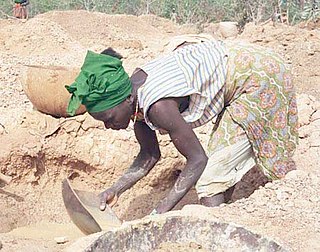
Transport in Guinea is composed by a variety of systems that people in the country use to get around as well as to and from domestic and international destinations.

Forécariah is a sub-prefecture and town located in western Guinea. Population 21,710.
Bukit Besi is a small mining town in Dungun, Terengganu, Malaysia, famous for its high quality iron ore.
Iron ore production in Africa is dominated by South Africa, Mauritania and Algeria; Zimbabwe and Morocco produce ore for use within the country. Many countries possess iron ore deposits that are as yet untapped/unmined. Countries and companies currently involved in production are listed here; measurements are in tpy, or tonnes per year.

Matakong is an island just off the coast of Guinea between the capital Conakry and the Sierra Leone border.
Railway stations in Guinea include:

Kalia is one of two towns in Guinea with this name. This is the one in Faranah Prefecture. It is east of the capital Conakry near Faranah and near to the border with Sierra Leone.

Naigaya is a village in southwest Guinea. It is near the border with Sierra Leone. Its elevation 411.0 metres (1,348.4 ft). It is in the Prefecture of Kindia.
The Muncelu Mic mine was a large open pit mine in the western of Romania in Hunedoara County, 16 km southeast of Simeria and 387 km north-west of the capital, Bucharest. Muncelu Mic represents one of the largest iron ore reserves in Romania having estimated reserves of 6.5 million tonnes of ore. When it was operational it produced around 200,000 tonnes of iron ore/year. The mine also has a gold and silver reserves of around 5.4 million tonnes grading 1g/t gold and 8g/t silver resulting 173,000 oz of gold and 1.38 million oz of silver.
The Ghelari mine was a large open pit, also an underground iron ore mine in the western of Romania in Hunedoara County, 20 km south-west of Hunedoara and 411 km north-west of the capital, Bucharest. Ghelari represents one of the largest iron ore reserves in Romania having estimated reserves of 14 million tonnes of ore. The mine produced around 200,000 tonnes of iron ore/year.
The Teliuc mine is a large open pit mine in the western of Romania in Hunedoara County, 15 km west of Hunedoara and 406 km north-west of the capital, Bucharest. Teliuc represents one of the largest iron ore reserves in Romania having estimated reserves of 3 million tonnes of ore. The mine produces around 100,000 tonnes of iron ore/year.
The Ocna de Fier mine is a large open pit mine in the western of Romania in Caraş-Severin County, 25 km west of Reşiţa and 511 km north-west of the capital, Bucharest. Ocna de Fier represents the largest iron ore reserves in Romania having estimated reserves of 200 million tonnes of ore grading 25% iron metal. The mine produces around 10,000 tonnes of iron ore/year.
The Băișoara mine is a large open pit mine in the north-western of Romania in Cluj County, 60 km south of Cluj-Napoca and 466 km north-west of the capital, Bucharest. Băișoara represents one of the largest iron ore reserves in Romania having estimated reserves of 6 million tonnes of ore. The mine produces around 50,000 tonnes of iron ore/year.
The Dognecea mine is a large open pit mine in the western of Romania in Caraş-Severin County, 23 km west of Reşiţa and 509 km north-west of the capital, Bucharest. Dognecea represents one of the largest iron ore reserves in Romania having estimated reserves of 9 million tonnes of ore. The mine produces around 10,000 tonnes of iron ore/year.
The Lueta mine is a large open pit mine in central Romania in Harghita County, 36 km west of Miercurea Ciuc and 299 km north of the capital, Bucharest. Lueta represents one of the largest iron ore reserves in Romania having estimated reserves of 6 million tonnes of ore. The mine produces around 10,000 tonnes of iron ore/year.
The Simandou mine is a large iron mine located in the Simandou mountain range of southern Guinea's Nzérékoré Region. Simandou represents one of the largest iron ore reserves in Guinea and in the world, having estimated reserves of 2.4 billion tonnes of ore grading 65% iron metal.
The Mount Nimba mine is a large iron mine located in southern Guinea in the Nzérékoré Region. Mount Nimba represents one of the largest iron ore reserves in Guinea and in the world having estimated reserves of 6 billion tonnes of ore grading 68% iron metal.
The Cacova Ierii mine is a large open pit mine in the north-western of Romania in Cluj County. Cacova Ierii represents one of the largest iron ore reserves in Romania having estimated reserves of 16.6 million tonnes of ore grading 42% iron metal. The mine has the capability to produce around 415,000 tonnes of iron ore/year.
The Rudăria-Bănia mine is a large open pit mine in the south-western Romania in Caraș-Severin County. Rudăria-Bănia represents one of the largest iron ore reserves in Romania having estimated reserves of 70 million tonnes of ore grading 45% iron metal and 20% manganese metal. The mine has the capability to produce around 500,000 tonnes of iron ore/year.

The mining industry of Guinea was developed during colonial rule. The minerals extracted consisted of iron, gold, diamond, and bauxite. Guinea ranks first in the world in bauxite reserves and 6th in the extraction of high-grade bauxite, the aluminium ore. The mining industry and exports of mining products accounted for 17% of Guinea’s gross domestic product (GDP) in 2010. Mining accounts for over 50% of its exports. The country accounts for 94% of Africa’s mining production of bauxite. The large mineral reserve, which has mostly remained untapped, is of immense interest for international firms.





